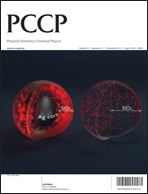Anisotropic dynamics of guest molecules in aerosol OT lamellar structures†
Abstract
The present work is focused on developing a description of an anisotropic microheterogeneous medium, exploiting the dynamics of a guest molecule. The medium in question is the lamellar structures formed in the aqueous layer of ternary mixtures containing aerosol OT (AOT), water and n-heptane. The guest used in this study is the fluorescent probe, coumarin 153 (C153). The dynamics of this molecule, within the lamellar structure, have been studied using a combination of steady state and time resolved fluorescence, as well as fluorescence correlation spectroscopy (FCS). The fluorophore is strongly solvatochromatic and so, the wavelength of excitation can be tuned so as to selectively excite fluorescent molecules residing in different regions of the microheterogeneous media, even if the spatial separation between these regions is below the diffraction limit. The excitation wavelength in the present experiments is chosen so as to exclusively excite those C153 molecules that reside in the hydrophobic region of the lamellar structures. This triggers two different modes of diffusion, one along and the other perpendicular to the bilayers of the AOT. Thus, the dynamics of the fluorescent probe provide an elegant manifestation of the anisotropy of the host medium.


 Please wait while we load your content...
Please wait while we load your content...